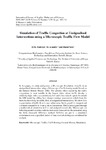| dc.description.abstract | In this paper, we study and present a Microscopic Simulation of traffic in an unsignalised intersection using a Microscopic Car Following model based on the General Motors Theory (GM). The adverse effect caused by the traffic congestions is most notable in the largest cities, where traffic density is relatively high, with characteristically low and often variable speed. It extends the GM model by adding lane change (turning) manoeuvres which form the basis for describing the traffic flow at unsignalised intersections. We show how augmentation of traffic flow in most urban areas due to growth in transport and continual demand for it forms at those intesretions. This is investigated through a mathematical simulation in C++ and analysed numerically. Microscopic car following model considers vehicles in discrete form and this discretization using the finite (forward) difference method. Vehicles are put in a simulation environment over a specified period of time over which they are considered for analysis. | en_US |

